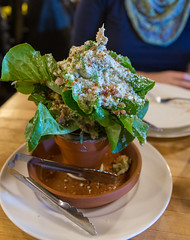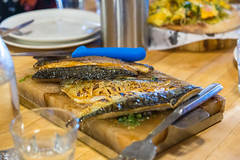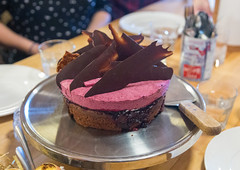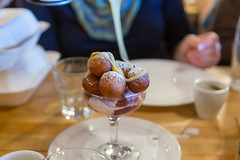As regular readers know, every few years I try to go to one of Quebec’s bigger culinary events, the Cabane à Sucre (“Sugar Shack”) event run by Montreal’s Au Pied de Cochon. It’s one of the Montreal-area big ticket events, and a bit of effort is required to score a reservation, usually requiring waking up at midnight to get a good spot on the waitlist. It is truly a culinary “shock and awe campaign”; you can read my writeups of my trips there in the winter of 2010 and 2017, but both of those visits were to the winter maple sugaring event (which is mostly a “how many dishes can a chef come up with that involve both foie gras and maple?” sort of event). But this year, we decided to mix it up a bit. In addition to their annual maple sugaring feast, Au Pied de Cochon also runs a fall harvest season event, focusing on apples and other fall harvest fruits and vegetables (with, again, an implausibly large amount of foie gras worked into the menu as well). So this year, I arose very early on April 1st, and managed to score a table for 8 in late October. So, rounding up an assortment of my local friends, we drove up to Montreal for a merry weekend of excessive dining, Montreal-style.
Aside from the decidedly nicer weather, the overall Cabane à Sucre experience at PdC’s rather nicely-appointed “shack” is basically a variant of the same winter experience: A large, boisterous dining room, large tables of food served family style, and course after course of an almost intimidating amount of food. It’s definitely more of a marathon than a sprint, and I heartily recommend all guests bring a lot of Tupperware for taking the leftovers home, since there will be leftovers. Like previous visits, this visit’s experience was much like being besieged by the kitchen, with a total of 13 courses! Compared to the winter Cabane experience, the menu is a bit tamer, but still aimed more at the adventurous eater than the cautious one.
First arriving at the table was a tartare of duck and oyster, served up in oyster shells with some quite tangy pickled chanterelle, sesame, and toasted pumpkin seeds. This was a very good combination: the oyster and duck combining nicely (with a bit of a sweet sauce added), the chanterelle adding both woody and acid notes, and the pumpkin seeds adding in a nice crunch. A bold start to the menu.
The second course was probably one of the most mainstream dishes I’ve been served up at Pied de Cochon, a squash pizza. Basically your classic flatbread pizza, with green tomato sauce, thinly sliced winter squash, topped with walnuts and a tangy squash Hollandaise. This was one of the surprise winners of the meal: the crust itself was nicely crisped up, the thinly sliced squash the perfect texture, and the combination of nuts, Hollandaise, and the green tomatoes giving a pleasing combination of flavors and texture.
A typical Pied de Cochon meal has at least one unusually presented dish, and in this case that was definitely the BLT salad. Delivered in a flowerpot to the table, this almost looks as if they’ve served up the lettuce to you without picking it, but it’s actually a ruse: the dish is several smaller heads of lettuce that have been carefully coated with a light Caeser-like dressing with a lot of bacon and tomatoes, and then threaded on a skewer, each diner removing one of the smaller heads from the skewer. A bit of a funky approach, but it basically worked.
Next, the fish course arrived, and unlike the rest of the meal, this was an expression of simplicity, a lightly glazed mackerel, served up with a light roasted finish. I’m not usually a great mackerel fan, but this worked nicely: the texture was perfect, and there was just enough smokiness from the roasting to bring out some extra flavor.
Next up was nominally a vegetable course, a “cauliflower steak”, roasted thick-sliced cauliflower served up with cheese, cauliflower purée, and foie gras (it’s Pied de Cochon, you aren’t getting out of there without at least one surprise foie gras encounter). This dish worked surprisingly well: the toasted cauliflower nicely complemented by the foie gras melting over it.
The cauliflower wasn’t the only foie gras dish, either. Next up were steamed dumplings, filled with spicy pork, eggplant, and foie gras. I’m not usually much of an eggplant fan, but everything here was great: the steamed dumpling itself a nice little bun, the filling a juicy hot pocket of duck fat, pork, and some nice vegetable notes from the eggplant.
Next up was the third in the trio of dishes with foie gras. In this case, a cheesy cavatelli served up with mushroom and foie gras. The neat thing here was the service: they brought the cavatelli out in a hollowed out cheese wheel, serving from that. This was a really good pasta, nice squat cavatelli cooked just to the point of being al dente, this was texturely a nice changeup from the other dishes.
It wouldn’t be a proper Pied de Cochon experience without at least one wildly-excessive, pork-related dish, and for this meal, it was a pig’s head. Actually, half of one (including tongue), roasted with a nice glaze, served up with apple sauce, house-made mustard sauce, and cole slaw, all of that served up over more pig parts (barbecued ribs, to be particular). I’m no stranger to the pig’s head, indeed, I’ve had almost exactly this presentation several times at Greenhouse Tavern. And this really worked: the pig head was actually a smaller one, but had really good layering of the cheeks, with some really good ribbons of fat between layers of nicely smoked meat (which is why I always call this “face bacon”). A bit of the mustard and cole slaw gave the face bacon a bit of crunch and tang, and while a bit messy, this was enjoyed by all.
The last main component of the meal was a lamb shank. This was served up alongside some corn tortillas, crema, salsa verde, and spicy salsa, allowing you to make up tacos. I do really like a good lamb shank, but to be honest, there was something about the spicing here that seemed off to me. It might be my expecting more of a Mexican spicing here (the lamb was a little sweet and minty, actually). Nothing bad (indeed, this made some great leftovers), but this was probably the weakest dish, also coming at a point where we were starting to get seriously full.
And if there’s any phrase that should be associated with the Pied de Cochon Cabane a Sucre, it’s “Mais attendez, il y a plus!” (“But wait, there’s more!”). After 9 courses already, everyone at the table is already approaching either “full” or “overfull”, and then they start wheeling out the dessert courses. This time, four of them. First up was gigantic (our table had two of these for seven people!) chocolate cake with chocolate ganache, blueberry/blackberry mousse. This was a really well executed cake as well: the cake was smooth, rich, and not overly sweet, the ganache firm but creamy, and the mousse a light, berry-laden sweet and tangy note tying it all together.
Next up was an impressive visual treat: individual egg creme brûlées, each served in its own shell, with a brilliant yellow sea buckthorn “yolk” (I had to look up sea buckthorn). Here, the small serving was appreciated: each little creme brûlée was a nice 2 or 3 spoonfuls of a nicely crackle-topped custard with just a bit of berry tanginess from the buckthorn.
A third dessert was the yogurt panna cotta with poached peaches and herb granita. To me, the best part was the delicate, perfectly poached peaches with just a bit of an herb note from the granita. Add in a bit of sweetness and dairy smooth from the panna cotta, and this was enjoyable, even though panna cotta usually isn’t something I’ll pick.
Finally, dessert concluded with donut puffs on strawberry ice cream, topped with maple dulce de leche. Here, everything was solid: the strawberry ice cream a richer, deeper strawberry flavor than usual. The donuts were perfectly crispy little rounds of dough with a bit of corn in them, giving an overall consistency a bit like goolab jamoon, soaking up the ice cream. Add in a fresh drizzle of maple dulce de leche, and this was a great way to finish up.
Just like my previous visits to the Cabane, the Fall Harvest visit was very enjoyable. The courses were delicious, inventive, and the perfect way to share a meal with friends, and everyone left with a huge amount of leftovers. What continues to amaze me is the price: for this visit, our table was $68.50cdn per person (~$52 American), for a good solid 13 courses of food with lots of leftovers. This place has to be a labor of love for Martin Picard, since the price is so affordable. So, whether going for the traditional winter feast (reservations start online December 1st at midnight ET each year), or the fall harvest feast (reservations open on April 1st), this is a Quebec culinary tradition worth exploring. It might just be another year and a half before I fully recover from this overindulgence.















